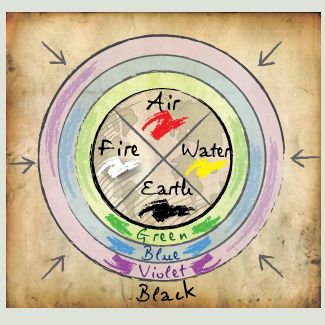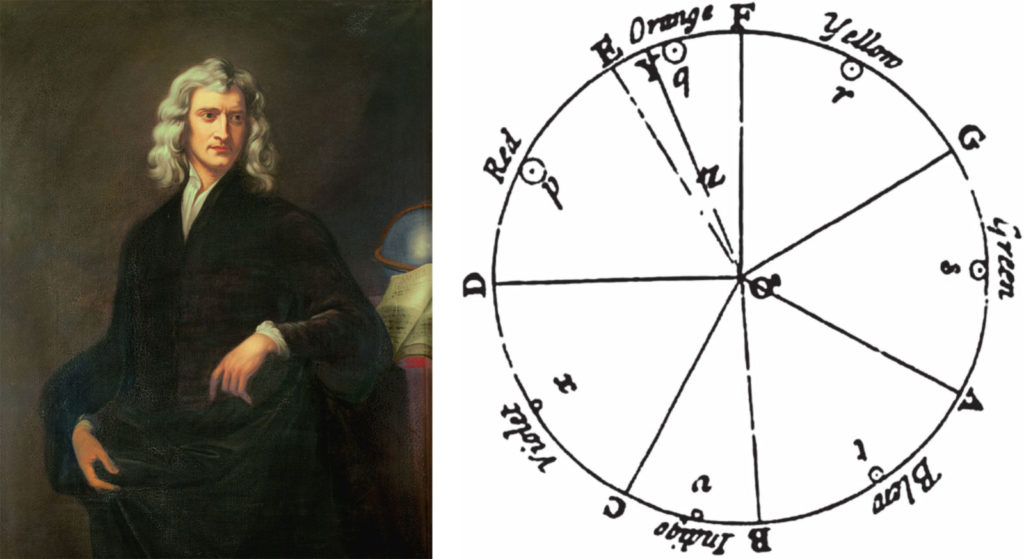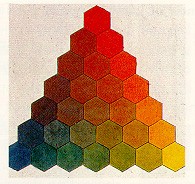Part 1: Classical Color Theory
Color theory plays an important role in the quilts that we make. For example, many of the colors that are used in transparency techniques involve the interaction of lightness and darkness. Also, we might make different color choices in our quilts based upon how colors interact with and complement one another. Let’s take a look at the history of color theory and see how some of these different theories are applicable to some of the quilting techniques that we might choose to explore in our creations.
Aristotle and Color in Ancient Greece
The history of color theory goes all the way back to Ancient Greece. Aristotle, one of the great philosophical minds of the day, believed that colors were sent by the gods through rays of light. He posited that all colors emanated from black and white (light and dark). He also related them to the different elements, air, earth, fire, and water. These beliefs were held for over 2,000 years until they were replaced by Newton’s theories on color.
Aristotle’s ideas on color might be applicable to quilting through several different ways:
● You might try working with different shades of light and dark colors while creating shapes and transparencies in your quilt.
● One of your designs could have a dark background and some of your transparencies could work with different color effects. ● You also might try working with different colors in your design that resemble the elements based upon your perception of them.

Newton’s Insight Onto Color Theory
Newton’s theory of color was entitled Optick and was developed during the early classical period, in 1704. His experiments focused on prisms. Newton’s early experiments with the prism held that a stream of visible light could be separated into different colors. Specifically, his work led to the theory that the primary colors are red, yellow, and blue. Furthermore, the secondary colors result from the mixing of those colors, specifically purple, orange, and green, which helps to give shape to the color wheel. The idea behind the color wheel is that it helps designers come up with different choices that complement each other nicely. For example, complementary colors from the color wheel would be red and green, which are opposite from one another.
Some ideas to help you apply Newton’s color theory to your quilting might include:
● Choosing some secondary colors that align with each other nicely, such as blue and orange.
● Using different sets of complementary colors to create more contrast in your quilts.
● Creating different sets of “light” and “dark” using complementary colors from the color wheel.

Goethe’s Theory of Colors
A more philosophical approach to color can be found in Goethe’s Theory of Colors. Goethe was a German philosopher who published this theory in 1810. Many of Goethe’s writings impacted artists and musicians during the classical period. Goethe had some unique insights on the theory of color:
● He didn’t see darkness as an absence of light. He saw darkness as being something that was polar to light and interacted with it.
● Instead of believing that color was solely derived from light and the color spectrum, like Newton’s prisms, Goethe believed that the colors we see are shaped by our individual perceptions, as well as the interaction of lightness and darkness.
● Goethe also derived a color wheel that was somewhat different from Newton’s. Goethe’s color wheel allowed for colors that were more complementary based upon perception.
Tobias Mayer and The Affinity of Color Commentary
Tobias Mayer was another color theorist that was not as widely known as Sir Issact Newton. His work The Affinity of Color Commentary was published in 1775, posthumously. In his work, he sought to determine the number of colors that the human eye could physically see. Mayer’s work abandoned the traditional color wheel. In fact, he started painting the corners of a triangle with red, yellow, and blue. He painted inwards, connecting the different opposing colors together. He attempted to compensate for different shades by stacking triangles with different brightnesses on top of each other. Ultimately, Mayer never developed a way to determine the number of colors that the human eye could see, but his triangles help see how different shades of colors are related to the different primary colors.

The Industrial Revolution and Colors
Over the years, chemists also unlocked different colors in their laboratories. Scientific advancements helped develop pigments, making way for different color saturation in dyes and inks. Chemistry also unlocked the different processes needed for color photography as well as for color printing. This enabled the development of more colors, such as cyan, magenta, yellow, and other unique colors. The development of chemistry and technology are responsible for many of the unique “modern” colors that appear in many modern quilts.
How Can You Apply Color Theory To Your Quilting?
Many people who partake in sewing, crocheting, and quilting might want to consider some of the modern quilting courses on this website that explore color. Here are some courses that you might want to explore:
● Befriending Colors: In this course you will learn about color theory and learn five different color schemes to try in your quilts.
● Playing with Color Value: .In this class, you will learn how Color value can be a key design element in your quilts.
● Curves and Transparencies: In this course, you will learn how to apply color theory to create different transparency effects with colors and fabrics.

